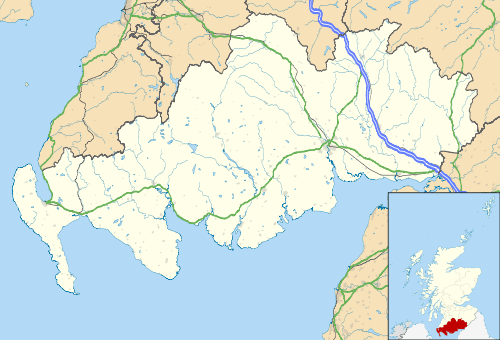New Luce
New Luce is a civil parish in Dumfries and Galloway, south-west Scotland. It lies in the traditional county of Wigtownshire, and is about 10 miles (16 km) in length and 5 miles (8.0 km) in breath, being the upper part of the original Glenluce Parish.[1] New Luce is shown as a civil parish on John Ainslie's county map of 1782.[2]
| New Luce | |
|---|---|
 New Luce Location within Dumfries and Galloway | |
| OS grid reference | NX174647 |
| Council area | |
| Lieutenancy area | |
| Country | Scotland |
| Sovereign state | United Kingdom |
| Post town | NEWTON STEWART |
| Postcode district | DG8 |
| Dialling code | 01581 |
| Police | Scotland |
| Fire | Scottish |
| Ambulance | Scottish |
| UK Parliament | |
| Scottish Parliament | |
New Luce is also the principal village within the parish. The coast to coast walk, the Southern Upland Way, passes close to the village.[3] The Covenanter Alexander Peden spent time preaching in the village.
Places of interest
A viaduct carried the Stranraer-Glasgow railway over the Main Water of Luce. Down the river from the viaduct is a pool called Bloody Wheel where the Hays of Castle of Park, near Glenluce (Old Luce), and the Linns of Larg in the adjoining parish of Inch, were said to have had a violent encounter centuries ago.[4][5]
Archaeology
The Caves of Kilhern, between 2,000 and 3,000 years old, are in south New Luce.
Cairn na Gath ("cairn of the wild cat"), near Balmurrie, is a chambered long cairn dating to the neolithic (later stone-age). At the south end there are remains of huts or enclosures.[6] In addition, there are ancient hut circles at Lagafater, around 8 miles to the north of New Luce.[7]
Cairn Macneilie, 100 metres (330 ft) north-west of Cruise, New Luce, is a Bronze Age round cairn, 56 feet (17 m) in diameter and 3 feet 6 inches (1.07 m) high.[8][9] There is another Cairn Macneilie at Inch Parks, by Lochinch Castle in Inch Parish. They may have been named after a person who conducted archaeological excavations.
Forts
Rev. George Wilson, in his Archaeological and Historical Collections relating to Ayrshire and Galloway, lists forts in New Luce:[10]
- Cruise Back Fell, fort marked on the map as two cairns, 80 ft long, on the Fell of Cruise or High Galdenoch.[11]
- Gleniron Several fort with a cluster of green rings, and a large ditch and mote.[12][13]
- Mid Gleniron [14]
- Mid Gleniron tomb, where the long cairn had enclosed an earlier smaller one.[15]
- Garvilland Iron-age hill fort on the Bennan, double at the one end and with hut circles.[16]
- Klashherne, two rings, and three more, not on O.S. map.[17]
- Balmurrie, ring with two hut circles.
Gallery
 'Caves' of Kilhern: six neolithic chambered cairns, estimated at between 2000 and 3000 years old
'Caves' of Kilhern: six neolithic chambered cairns, estimated at between 2000 and 3000 years old Cairn na Gath, near Balmurrie
Cairn na Gath, near Balmurrie Cairn na Gath. This is a chambered long cairn dating to the neolithic
Cairn na Gath. This is a chambered long cairn dating to the neolithic Bennan of Garvilland Iron Age hill fort
Bennan of Garvilland Iron Age hill fort Bennan of Garvilland hill fort - entrance
Bennan of Garvilland hill fort - entrance Bught Fell and Kilhern Moss
Bught Fell and Kilhern Moss Looking across open moorland to the cairn on Cairn Park, behind Glenchamber
Looking across open moorland to the cairn on Cairn Park, behind Glenchamber Southern Upland Way near Cairn Macneilie, Cruise
Southern Upland Way near Cairn Macneilie, Cruise A windfarm at Artfield Fell, east of New Luce
A windfarm at Artfield Fell, east of New Luce Laggangairn Standing Stones
Laggangairn Standing Stones Viaduct over Main Water of Luce
Viaduct over Main Water of Luce
References
- http://www.dgcommunity.net/communitycouncil/default.aspx?id=56
- "View: A map of the county of Wigton. - Counties of Scotland, 1580-1928 - National Library of Scotland". Maps.nls.uk. Retrieved 9 September 2012.
- http://www.newlucehistory.co.uk/
- National Archives of Scotland GD72/142(i). 13 May 1662. Bond by Sir Thomas HAY, younger of (Castle of) Park, and William LIN of Large, as cautioners to William GORDON of Craiglaw
- National Archives of Scotland. GD135/798, 800, 804, 955. c.1687
- http://www.explorebritain.info/antiquity-dumfries-and-galloway-cairn-na-gath-nx2167
- "Lagafater Lodge". Canmore. Historic Environment Scotland. Retrieved 9 September 2016.
- http://www.megalithic.co.uk/modules.php?op=modload&name=a312&file=index&do=showpic&pid=9711
- http://canmore.rcahms.gov.uk/en/site/61666/details/cruise+cairn+macneilie/
- Archaeological and Historical Collections relating to Ayrshire and Galloway. vol.V. pp.63-64 https://archive.org/stream/cu31924092901606#page/n115/mode/2up
- http://www.scotlandsplaces.gov.uk/search_item/index.php?service=RCAHMS&id=61644
- http://www.scotlandsplaces.gov.uk/search_item/index.php?service=RCAHMS&id=61598
- http://www.themodernantiquarian.com/site/5620/
- http://www.scotlandsplaces.gov.uk/search_item/index.php?service=RCAHMS&id=61594
- Discovery and Excavation 1963, 51ff ; Corcoran. 1964 http://www.dgnhas.org.uk/
- http://www.scotlandsplaces.gov.uk/search_item/index.php?service=RCAHMS&id=61599
- http://canmore.rcahms.gov.uk/en/site/62443/details/bught+fell/
| Wikimedia Commons has media related to New Luce. |